
views
X
Research source
Clinical Procedures in Vet Nursing. Aspinall. Publisher : Butterworth-Heinemann
The following offers instructions for how to proceed with each.
Using a Styptic Pencil
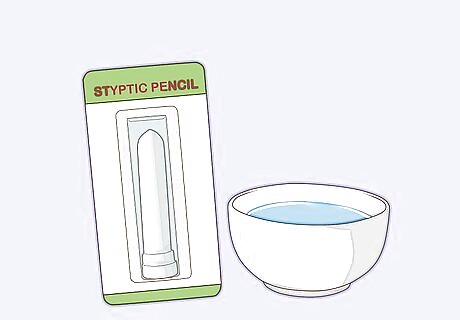
Gather supplies. If you’re using a styptic pencil, you’ll need it and a bit of water to moisten it with. Styptic pencils are relatively easy to obtain and contain an astringent that stimulates blood vessel contraction, which encourages bleeding to stop. Styptic pencils are available from most pharmacies. You can also use a styptic powder to treat the bleeding.

Remain calm. Hopefully you’ve anticipated this scenario, and, if you happen to cut the quick, you can calmly reach the materials you gathered beforehand. The blood loss from a bleeding quick is not dangerous to a healthy dog. The bleeding nail can, however, look a bit alarming, especially if the dog is scrambling around and spreading blood over the floor. Know that the dog is in no danger, but act quickly to minimize its discomfort. Remember that remaining calm is important for you but also for your dog. The quick is tender and full of nerves, so having it clipped will be painful to your dog and it will be looking to you for cues about how to react. If you get panicked or frantic, your dog likely will, too.
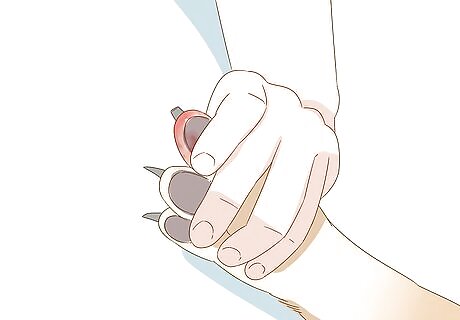
Staunch the bleeding. The quick is located in the center of the nail, and you'll see blood seeping from this area. Grab your styptic pencil and remove any packaging. Expose and moisten the tip of the styptic pencil.

Apply the styptic pencil. Hold the bleeding toe steady and gently restrain your dog to prevent it from moving while you apply the styptic pencil. Place the styptic pencil directly in contact with the bleeding toe and press firmly. Keep the pencil held firmly in place for at least 2 minutes, then remove.

Repeat. If the bleeding hasn't stopped, repeat the process above but hold the styptic pencil in place for 5 minutes. The bleeding should stop after holding the pencil in place for five minutes. If it doesn’t phone your vet and ask whether you should bring your dog in.
Using a Bar of Soap

Collect your supplies. If you’re using a bar of soap, the soap is the only thing you’ll need. An ordinary bar of soap, when pressed into the claw, will form a plug that covers the quick, like putting a cork in a bottle. This plug generally dislodges itself several hours later and needs no further attention.

Maintain your calm. Ideally you’ve prepared yourself for this situation and can calmly use the materials you have ready at hand to stop the bleeding. A healthy dog won’t be at risk from blood loss from a bleeding quick, but the blood can be somewhat alarming, particularly if your dog seems distressed. Know that the dog is in no danger, but act quickly to minimize its discomfort. Remaining calm is important to both you and your dog. If you cut the dog’s quick, the dog will likely be distressed and will look to you for cues on how to react. If you show alarm or become frantic, your dog likely will, too.
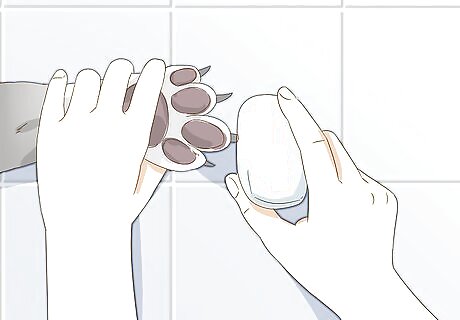
Hold the bleeding nail at 90 degrees to the dry soap. Gently restrain your dog to keep it still as you do this. Push firmly so that the nail is embedded into the soap to a depth of approximately 3 - 4 millimeters.

Hold the foot still in this position for 3 - 4 minutes. This places gentle pressure on the blood vessels and stops them from bleeding. Remove the toe from the soap after 3 - 4 minutes with a gentle twisting action. If your dog won’t hold still, push the claw firmly into the soap and then remove the soap with a slight twist of the wrist.
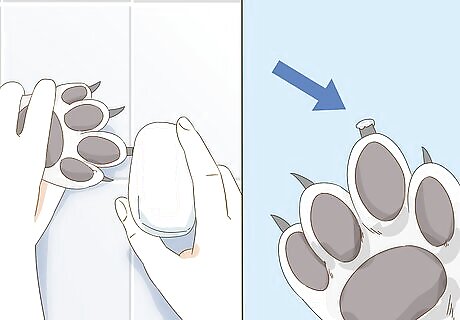
Repeat. If a plug doesn’t form, repeat the above process again, pressing the claw into the soap until you’re successful. You’ll know a plug has successfully been formed when the soap is blocking the tip of the nail and no more blood is seeping through. If the bleeding won’t stop, contact your vet.
Using Potassium Permanganate
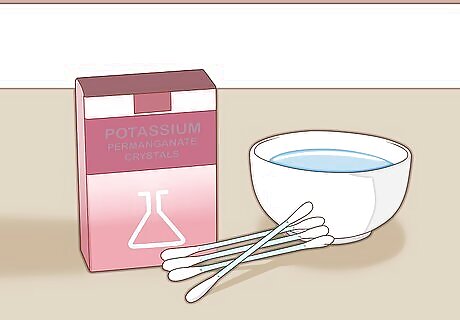
Get your supplies ready. If you’re using potassium permanganate, you’ll need the potassium permanganate crystals, cotton swabs, and a bit of water to moisten the swabs. Potassium permanganate is a powder made up of bright purple crystals and is the preferred method of veterinarians to stop bleeding nails. It’s highly effective and the permanganate is a natural disinfectant. Potassium permanganate crystals are widely available on internet retail sites.

Stay calm. Ideally you’ve anticipated this scenario and can calmly use the materials you’ve prepared to stop the bleeding. The blood loss from a bleeding nail is not dangerous to a healthy dog. The bleeding nail can, however, look a bit dramatic, especially if the dog scrambles around spreading blood all over the floor. Know that the dog is in no danger, but act quickly to minimize its discomfort. Remember that remaining calm is important for you but also for your dog. The quick is tender and full of nerves, so having it clipped will be painful to your dog and it will be looking to you for cues on how to react. If you get panicked or frantic, your dog likely will, too.
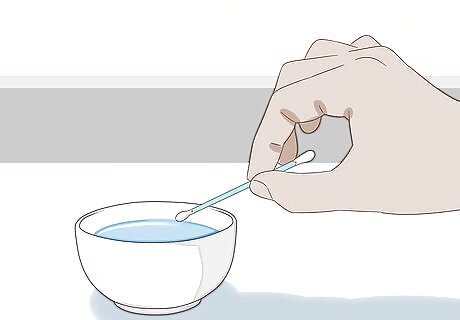
Moisten the tip of a cotton swab with water. It’s important that the swab be slightly moist so that the potassium permanganate crystals will adhere to it. You don’t need to soak the swab, just dampen it with a few drops of water.
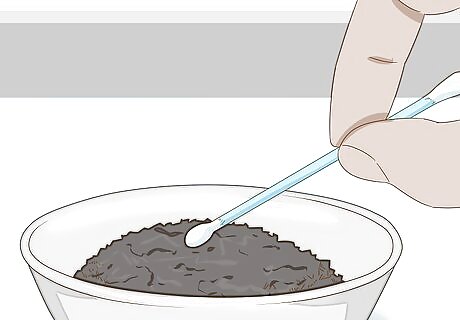
Dip the moistened cotton swab in the potassium permanganate. The crystals should stick to the moistened swab. Dip the end of the moistened swab into the potassium permanganate 1 time.
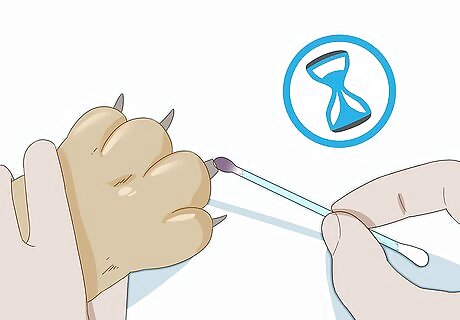
Press the swab into the bleeding quick and hold for 30 seconds. Gently restrain your dog while you apply the swab. The bleeding should stop fairly quickly.

Repeat. If the bleeding hasn’t stopped, repeat the above process again, this time holding the swab in place for 5 minutes. If after 5 minutes the bleeding still hasn’t stopped, contact your vet.
Contacting the Vet

Contact your vet if the bleeding continues. In the unlikely situation that none of the methods above work to stop the bleeding, phone your veterinarian for advice. If the vet recommends bringing your dog in, calmly begin preparing your dog for transport.
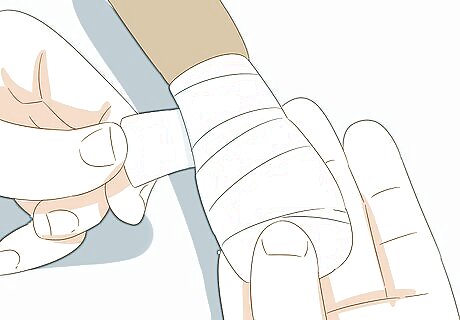
Bandage the paw. Do your best to bandage the paw before transporting your dog to the vet. Use a bandage from a first aid kit to put a temporary dressing over the paw to help stop the dog from hitting the sore nail and to keep the car a bit cleaner. Alternatively, you can place a swab or gauze dressing over the toe and wrap a bandage around the paw to hold it in place. Put enough tension on the bandage that it grips the paw and doesn't fall off, but don't pull it too taut or the bandage may cut off circulation to the paw. If the bandage is too tight, your dog will seem distressed and chew at the bandage; if that happens, loosen the wrapping. If you don’t have access to a first aid kit, wrap clean toilet tissue or cotton wool around the toe and apply a tight-fitting sock over the paw to hold it in place. If you have someone available to help, ask them to hold cotton wool over the nail while you’re en route to the vet.
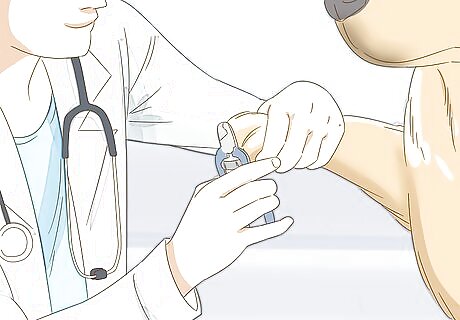
Have the vet or a professional groomer trim your dog’s nails. If you find that you have difficulty trimming your dog’s nails yourself, perhaps because you’re nervous about hurting your dog or your dog has learned to fear nail trimmings, you best option may be to try having it professionally done. If your dog shows noticeable distress at going to the groomer’s or to the vet’s, you might consider asking the vet or groomer to show you better strategies for trimming your dog’s nails at home. If you’re able to get more comfortable trimming the nails yourself, you may be able to avoid giving your dog the extra anxiety that may be associated with going to the groomer or vet.

















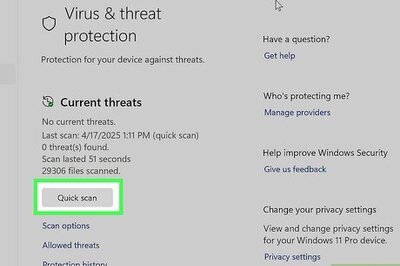


Comments
0 comment